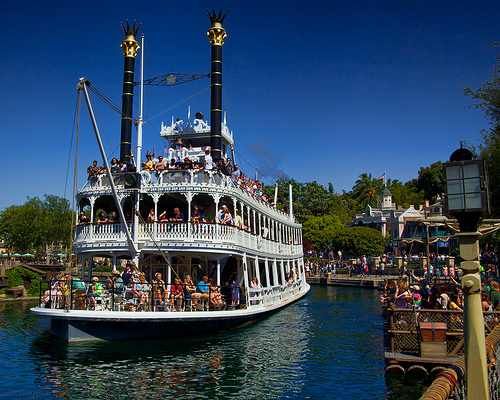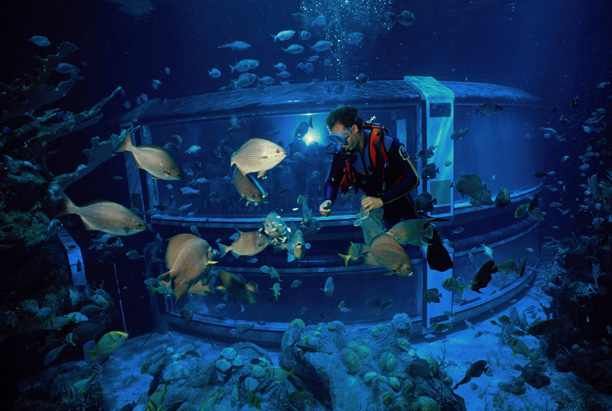
As we get into the heat of summer (and hasn't is come early this year?), we mom's are often reminding our kids to get plenty of fluids. Thanks to our latest Imagineering DVD I have learned that "fluids" and "liquids" are not the same thing--at least not from a scientific point of view. A fluid is a substance whose molecules flow freely and takes the form of the container holding it. This is often a liquid, but could be a gas or something a little harder to descibe--like toothpaste. This DVD seemed a little more mature--that is fewer sight gags, cartoons, etc. (There is one quick reference to flatulance with an accompanying noise).
Asa's Invention: The Pneumatic Food-Matic 5000. The workspace is filled with tubing as Asa tries to bring food to hungry park guests who may not be near an eating establishment (is that even possible in Disney World?) Working like those tubes at the bank, a small capsule should deliver a hamburger from the kitchen as the fluid (in this case, air) flows from high pressure to low pressure. Of course, it needs a little tweaking.
Defined Terms: Fluid, Fluid Dynamics, Archimedes Principle, Neutrally Buoyant, Pressure, Hydraulic System, Mechanical Advantage
Disney Rides and Attractions that exemplify the theme:
 While the principle is true for all the themed vessels in Disney's flotilla, we focus on the Mark Twain Riverboat. How can something that weighs so much float? Asa has a large container of water and a wooden cube that floats. A metal cube of the same size sinks to the bottom. In order to make the metal object float we need to change it's shape to displace more water. When the weight of the water being displaced exceeds the weight of the object it will float. By flattening out the bottom and raising the sides, the boat pushes away more water, but the additional volume holds air which doesn't add to the weight.
While the principle is true for all the themed vessels in Disney's flotilla, we focus on the Mark Twain Riverboat. How can something that weighs so much float? Asa has a large container of water and a wooden cube that floats. A metal cube of the same size sinks to the bottom. In order to make the metal object float we need to change it's shape to displace more water. When the weight of the water being displaced exceeds the weight of the object it will float. By flattening out the bottom and raising the sides, the boat pushes away more water, but the additional volume holds air which doesn't add to the weight. If you want to see a lot of fluid, it's hard to find more in one spot that the Living Seas with Nemopavillion at Epcot. This is one of the biggest single aquariums in the world. Asa learns about the
 principles of buoyancy with a scuba diver in the big tank. First he needs to add weights to his weight suit to overcome the natural tendency to float. Then he either adds air or releases it from his buayancy compensator vest to ascend or descend in the water. He can also stay at a stable level (neutral buoyancy). Some fish have built in swim bladders to accomplish the same thing. Others, like a shark, would sink to the bottom if they stopped swimming. There is also an experiment with an empty milk jug showing how pressure increases on all sides as you go deeper in water. Interesting note: the large windows of the tank are six inches think at the bottom than the top and are only held in place by the pressure of the water.
principles of buoyancy with a scuba diver in the big tank. First he needs to add weights to his weight suit to overcome the natural tendency to float. Then he either adds air or releases it from his buayancy compensator vest to ascend or descend in the water. He can also stay at a stable level (neutral buoyancy). Some fish have built in swim bladders to accomplish the same thing. Others, like a shark, would sink to the bottom if they stopped swimming. There is also an experiment with an empty milk jug showing how pressure increases on all sides as you go deeper in water. Interesting note: the large windows of the tank are six inches think at the bottom than the top and are only held in place by the pressure of the water. Sometimes it may not be so obvious that fluids are involved in a Disney attraction. Take the Dinosaur ride and Animal Kingdom. This ride takes place in a car--no water in sight. If you could peel away the "skin" of the large audio-animatronics you would find hydraulic pumps at work. The uncompressible liquids being force through small tubes are capable of applying thousands of pounds of pressure and move the limbs and necks of the massive creatures. Disney is very reluctant to ruin the "magic" for anyone so they don't actually show the animatronics without its covering, instead it's explained with a cartoon image.
Sometimes it may not be so obvious that fluids are involved in a Disney attraction. Take the Dinosaur ride and Animal Kingdom. This ride takes place in a car--no water in sight. If you could peel away the "skin" of the large audio-animatronics you would find hydraulic pumps at work. The uncompressible liquids being force through small tubes are capable of applying thousands of pounds of pressure and move the limbs and necks of the massive creatures. Disney is very reluctant to ruin the "magic" for anyone so they don't actually show the animatronics without its covering, instead it's explained with a cartoon image.The last ride is Grizzly River Rapids in California Adventure (although it could be Kali River Rapids in Animal Kingdom). The imagineers can control the speed of the circular boats by changing the width and depth of the channel of water. They also use "turbulators," or obstacles on the bottom of the channel to create the whitewater on the top of the water.

Quiz: 15 questions. If you get one wrong you will view a clip containing the correct answer before being given a chance to answer the question again.
Try It Yourself: Two great experiments this time and easy to accomplish at home. The first has been performed by magicians around the world. It turns out it's science not magic! Take a glass and fill it with water to the brim. Place a paper plate over the top and invert the two together, then remove your hand from under the plate. The plate will "stick" to the glass and the water won't fall to the ground because the air pressure on the outside is greater than the weight of the water in the glass.
The second experiment is to discover how long a straw you can build and still be able to suck water up through it. Using soda straws and duct tape see if you can lift water up the stairs of your home or from a high deck to the ground. It turns out the most you can do is about 33 vertical feet.
We're reaching the halfway point in the Imagineering series and are loving everyone. I really hope you try to get these through inter-library loan.

No comments:
Post a Comment